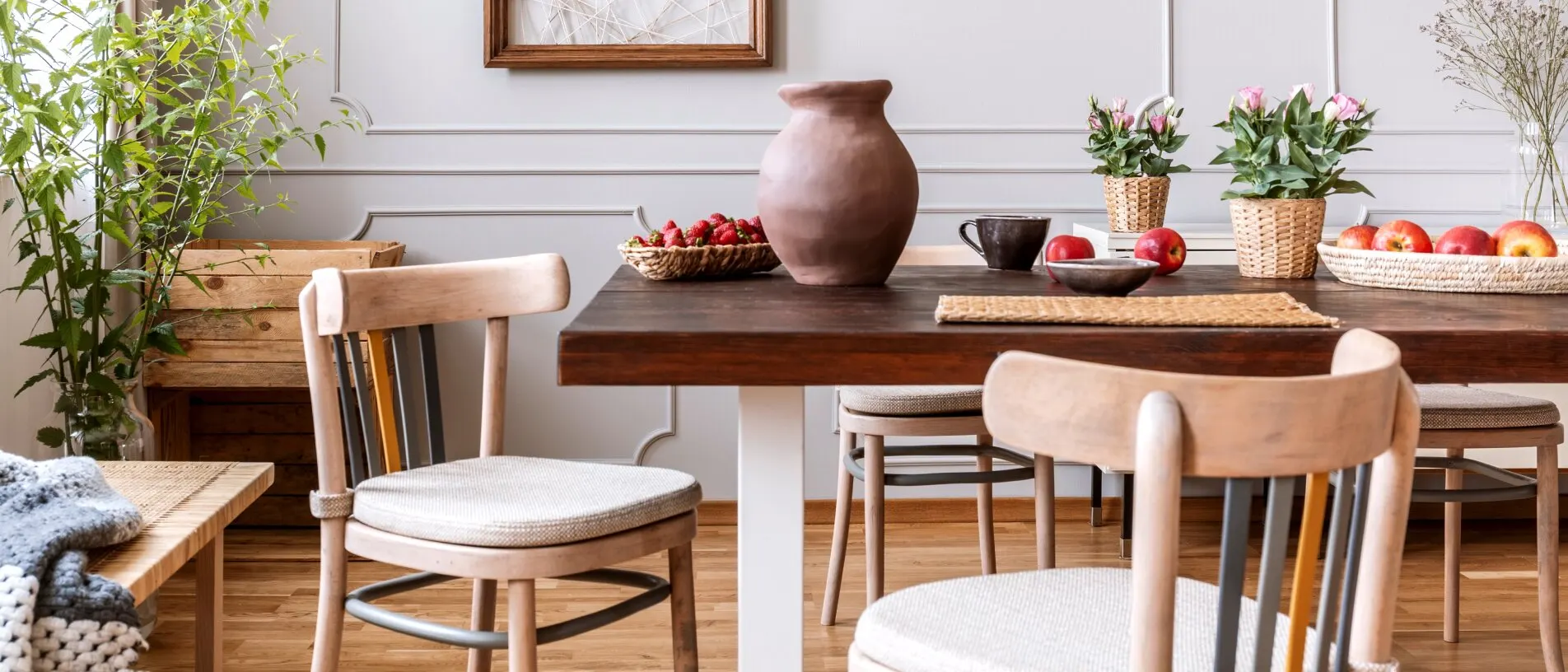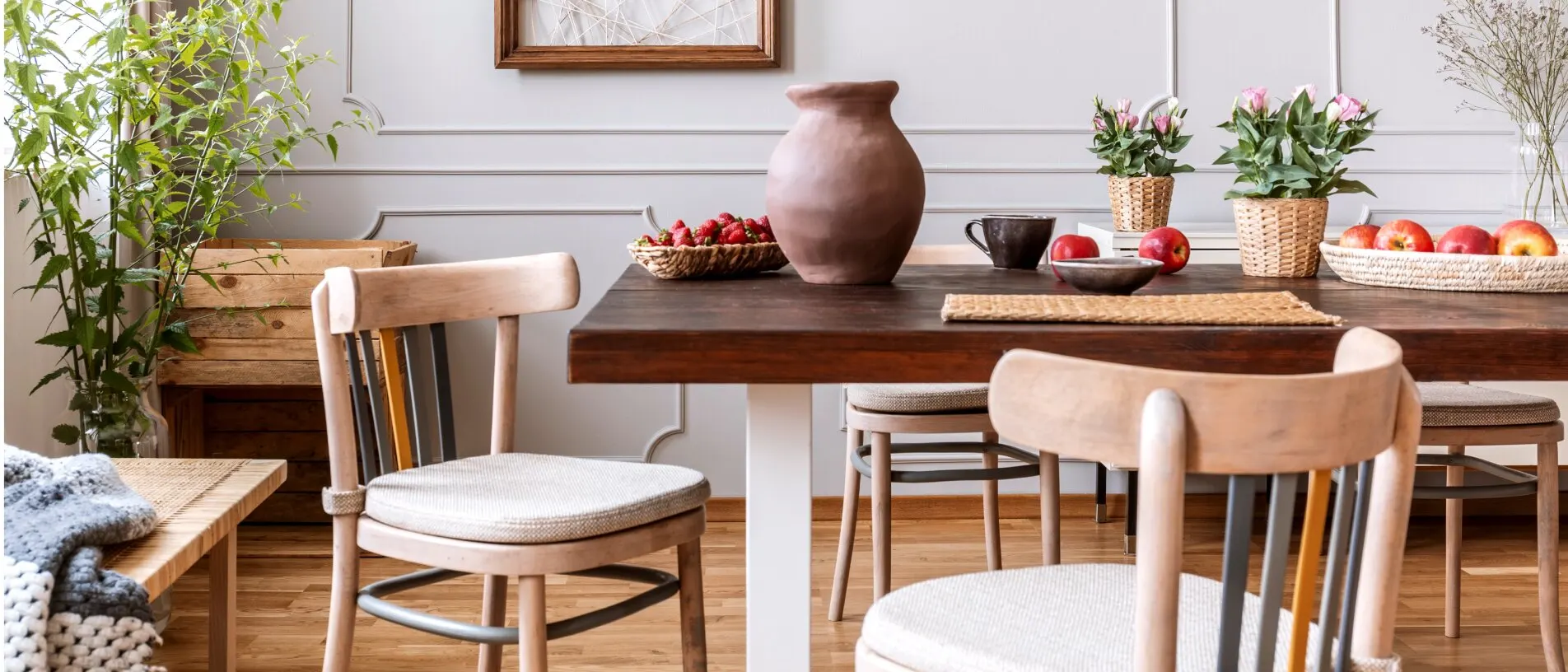You're on the list
By signing up, you agree to receive email marketing.


If you don’t buy all of your wood furniture at the same time in a matching set, it’s nearly impossible to perfectly match the finishes. The addition of wood floors and other built-in details further complicates the issue. The good news is that mixing wood finishes can create interest, depth, and definition in any space.
Most people acquire their furniture over the years, with some bought, some inherited, and some integrated as families or roommates come together. With a few designer tricks, you can embrace multiple finishes and pull together a sophisticated and appealing room. Look for similar styles, undertones, and grains, or create a buffer to coordinate when the tones don’t quite work side-by-side.
Here are a few more strategies for building an engaging, layered look with assorted wood finishes.
People often refer to colors, undertones, and finishes when discussing wooden furniture. These terms might seem similar, but they describe different elements.
The color is the primary shade you see on the surface of the wood. Some wood furniture retains its natural color, while others have been stained. For example, an oak bookcase can be a natural light tan or stained to a darker brown.
Undertones are the subtle secondary shades that appear within the surface color. These hues influence the wood’s overall appearance and relationship to other wooden furniture. An oak bookcase may have undertones of golden blond, cool blue, or reddish-brown.
Finally, finishes are coatings applied to the surface of wood. These layers seal the wood to protect it from moisture, scratches, and other hazards. Some furniture pieces have clear finishes, while others are stained or painted.
Here are a few popular woods and their colors:
Pine: Creamy yellow or white with yellow undertones
Maple: Light white or tan with ivory undertones
Red oak: Light reddish-brown with warm pink or yellow undertones
White oak: Light tan to medium brown with neutral undertones
Mahogany: Rich reddish-brown with hints of orange
Cherry: Deep reddish-brown that darkens with age and has red or pink undertones
Wood tones typically fall into one of three categories: warm, cool, or neutral. Choose tones from the same family to create a cohesive and intentional look.
Warm wood stains featuring red or yellow undertones work together whether light or dark in intensity. For example, you could place a red oak bookcase near a cherrywood coffee table to make your living room feel cozy and inviting.
Meanwhile, cool, ashy gray finishes easily harmonize in different saturations for a polished look. To create a refined dining space, you might pair a gray oak dining room table with an ash sideboard.
Avoid mixing too many warm and cool undertones. These combinations can make a room look chaotic and disjointed, creating a cluttered and unwelcoming atmosphere.
Cool wood tones have shades of blue, gray, or grayish-brown. They infuse rooms with peace and serenity, so they’re perfect for spaces designed for relaxing. For instance, you could include cool tones in your bedroom to help you wind down at night.
Warm wood tones have hints of red, orange, or yellow. These colors evoke the sunlight and create a cozy and welcoming atmosphere. Use warm tones in spaces where you want to feel energized and upbeat, such as the kitchen and home office.
Mixing wood tones might seem complicated, especially if you have a lot of different furniture to work with. But don’t worry. Anyone can combine wood tones effectively by following these simple steps.
Start by picking a primary wood tone to anchor your space. This color will guide your decisions as you choose additional furniture and decor.
Many people use the color of their hardwood floors as their dominant tone. For example, if you have a cherry floor, you might pick wooden furniture with complementary red hues.
You can also choose your main tone based on a focal point in the room. Wooden kitchen cabinets often have striking colors, while wooden bookcases and other large furniture can grab attention.
Next, choose complementary undertones that mesh with your primary color. Pick colors in the same family to create a harmonious space. For example, a cherry hardwood floor goes well with golden yellows, rich oranges, and other warm hues. On the other hand, pine cabinets would match furniture with cool blue and gray tones.
Feel free to mix different colors from the same category to create visual contrast. Suppose you have a dark mahogany TV stand in your living room. You could add furniture with other warm tones, such as a medium red oak coffee table and light pine end tables.
Next, choose complementary undertones that mesh with your primary color. Pick colors in the same family to create a harmonious space. For example, a cherry hardwood floor goes well with golden yellows, rich oranges, and other warm hues. On the other hand, pine cabinets would match furniture with cool blue and gray tones.
Feel free to mix different colors from the same category to create visual contrast. Suppose you have a dark mahogany TV stand in your living room. You could add furniture with other warm tones, such as a medium red oak coffee table and light pine end tables.
Choosing similar finishes will help your wood furniture blend together. There are many types of wood finishes, including lacquer, shellac, stain, and varnish.
If you have disjointed wood furniture, consider applying your own finishes. For instance, you could stain two chairs with a similar hue for a more unified appearance.
Use accent pieces to add new textures and separate clashing or mismatched wood tones. A few common accent pieces include curtains, houseplants, painted accent walls, throw pillows, rugs, wall art.
Successfully mixing wood tones can add depth and a beautifully layered look to any room. From rich dark woods to more neutral options, combining tones can open up a whole world of aesthetic possibilities.
But, of course, creating a harmonious wood palette isn’t as simple as it sounds. Besides the obvious limitations related to budget, you also have to grasp how to pair the proper tones together. And the easiest way to start is by understanding neutrals.
The so-called “neutral” wood tones are versatile and work well in almost any setting, room, and aesthetic. These are woods that are neither too warm nor too cold, allowing you to experiment without overwhelming the space.
These neutrals can serve either as an all-around backdrop for other colors or as the centerpiece in your palette. Neutral tones include woods ranging from light to medium brown. Some common examples of neutral woods are:
These woods offer a muted hue that will blend perfectly with bolder tones to create a cohesive, balanced look. They can also help bridge light and dark woods if you’re planning on mixing very different shades in one area at the same time.
Yes, oak and ash can go well together — as long as you understand the nuances of each one.
Oak is a classic choice that’s available in several different shades, from light honey to dark chestnut. Because ash is one of the lighter types of woods out there, you first have to consider whether you’re looking for a clash of tones or a mellow transition between the two.
For example, using a darker oak as the main material in your dining table but picking ash for the surrounding furniture can add some visual interest without clashing.
For a more harmonious look, aim to keep the oak in a similar tone to that of the ash. However, keep in mind that it can feel a bit too boring if all your furniture and decor are made out of wood. Make sure to incorporate some other pieces of decor like houseplants, throw pillows, and other designs to break up the monotony.
Experimenting is always fun — but sometimes, it’s best to go with what we know will work. Certain combinations consistently work well in interior design, adding style and depth to any space. Here are some key combinations to keep in mind:
Cherry and walnut: Cherry wood can bring a lively touch of reddish warmth to the understated, grounded shade of oak. This contrast can be fantastic for creating a focal point with the cherry, creating an inviting but manageable ambiance.
Dark walnut and light maple: Walnut is a deep, rich wood that pairs beautifully with the bright elements of maple. While bold, this combination is incredibly effective when used in more modern aesthetics.
Espresso with gray tones: Gray-toned woods are a staple of modern interior design, and pairing them with the intense look of espresso wood can add a chic touch to a contemporary look. Of course, the gray wood should be used as a complement to the espresso centerpiece.
Lastly, you should always consider the rest of your furniture and decor before mixing wood tones. Textiles, accent pieces, and the lighting can all change how the woods mix up in the end — even if these combinations are generally proven to work.
If you can, try to get a hold of some sample woods to compare them in person right from the comfort of your home.
Mixing wood tones lets you repurpose your existing furniture into new designs. You can also use these strategies to choose new furniture with complementary shades and create a harmonious look.
Whether you want a warm entertainment space or a cool refuge, wood tones will help you create the perfect mood.
Explore More
You're on the list
By signing up, you agree to receive email marketing.